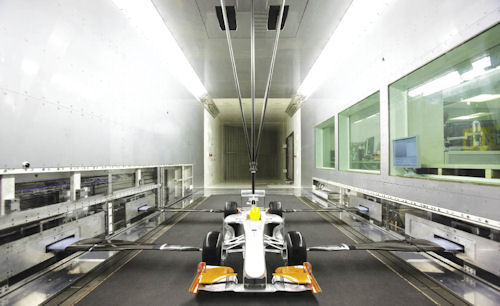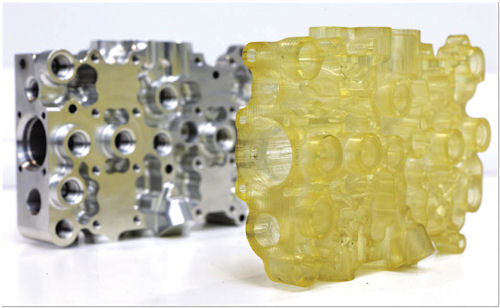Latest News
December 1, 2012
By Susan Smith
Formula 1 car racing is both a driving competition and an engineering competition. That’s is how James Allison, technical director at Renault Lotus F1 Team in the UK, describes it. The people involved are often referred to as “constructors” rather than teams because they have to build critical parts of their own car. They have to design it, too.
What separates the competition is the aerodynamic efficiency of each car. The Lotus F1 Team, for example, has 500 or so people on the technical side—and nearly 100 of them are only working on aerodynamics. Their wind tunnel program runs more or less 24/7 yearly. Over the course of a year, they test tens of thousands of new ideas.
Each of those ideas is tested on a 60% scale model of the full-sized car.
“We make tens of thousands of new parts of that model each year, searching for improved aerodynamic performance,” Allison says. “And those parts are all one-offs—prototypes, so we need a production system that is capable of keeping up with an insatiable demand for this wind tunnel and the people who are thinking up, designing them and wanting them tested.
“We need a manufacturing system that’s capable of handling that sort of throughput, where each component is a one-off and complex in its shape,” he adds. “It’s all flowing, 3D aerodynamic-detailed shape, so no straight lines, no easy angles. Everything is made to get the most of out of the air, not to be manufacturable. That’s the perfect environment for what 3D printing can bring.”
When the early rapid prototyping machines came on the market, the Lotus team was able to print complex shapes out of liquid using early stereolithography (STL) polymer liquids. In 1998, the Renault F1 Team and 3D Systems became partners, when Renault began using the SLA 5000 System to develop prototypes of components with a size-fit test function. This led to expanding the use of solid imaging technology to manufacturing of wind tunnel models, and the direct manufacturing of production parts for testing and racing.
The team has expanded from STL to selective laser sintering (SLS) machines, and a wide range of materials that allow them to put all these components into the wind tunnel model at a rate that keeps up with the optimization of the car.
Out of the Tunnel
As the technology has matured, they have begun to use it more away from wind tunnels and in the car itself.
“When we make our gearboxes, they are thin wall titanium investment casting, and we make the investment casting using a lost wax process, which is done on our SLS machines,” Allison says. “We send these parts off to the casters, where they get used as the patterns for the gearbox casings on the car. There are quite a few cast metal pieces that are used in the car, and we do all pattern work on our machines.”
 |
| About 80% of the surface of the model used in wind tunnel testing is made via 3D printing. |
Allison says there are also a large number of components that go on the car itself, as well as anything that requires a very complex, dark shape “where we need to get cooling air from the outside of the car to the inside of the car.”
“We can just print off the relevant serpentine duct and have it fit the car and go racing with it, because the materials are now light, stiff, tough and good enough to survive in the environment of the circuit,” he says. “It has transformed F1. Now we cannot imagine how to do without it.”
Allison explains that all the parts they make are one-off prototypes, which are actually functional. The finished component is made of material you can use; it can take significant loads and withstand reasonable temperatures.
“And they can work beautifully in our environment to allow us to find more down force every day with our car,” he says. “They are prototypes, but they are also working prototypes: They do their job, they get crushed up and we make another 100 the next day.”
The majority of the actual racecar is built with carbon fiber, but within it are a number of detailed components that are provided by additive manufacturing technology, such as lots of little trays for holding electrical equipment, and cooling ducts to take air from one part of the car to another part of the car. Certain aerodynamic components on the outside of the car redirect air rather than have a great amount of force on them themselves.
 |
| The prototype of a hydraulic manifold, with the final aluminum component in the background (example of size fit test prototype). |
The gear box case and the other significant investment castings on the car are only manufacturable with the accuracy and time scales because the team is able to print the pattern work for those directly on their machines at the factory.
Tens of Thousands of Components Each Year
Allison said that they produce approximately 100 components a day. There are about 40 wind tunnel experiments daily. Each experiment isn’t just a single component because normally, you’re fitting something to the left-hand side of the car and the right-hand side of the car. This means for every new idea, you’re fitting at least two components. But over the course of the year, those 40 tests a day gradually turn into improvements.
The manufacture of these tens of thousands of components a year can result in finding improvements in the aerodynamic efficiency of the car on the order of 12%, Allison says. This equates to 1% per month—which doesn’t sound like a lot, but the yearly average is worth over a second a lap.
“If you’re a fan of the sport, you’ll know that in qualifying the cars, they are normally separated by the less than a tenth of a second, so one second is worth about 10 places at the start of a race, so it’s a big deal,” Allison says. “A championship-winning car typically has an advantage of two-tenths of a second or so over competitors. This effort is critical to the future of the team, and good aerodynamic judgments are our lifeblood.”
He stresses that this could not be accomplished without a manufacturing system “that was capable of realizing all our ideas and testing them in the tunnel. A good idea might yield a quarter of a percent of improvement, so maybe four a month, one per week—out of 350 things you did that week, you might get one thing that was good. The challenge to find an incremental improvement to a design that has already had thousands of hours lavished on it is real.”
The Lotus F1 team has critical requirements in terms of engineering materials that can withstand real loads and temperatures, and they also offer input to 3D Systems as to what they need in terms of strength and stiffness.
Contributing Editor Susan Smith has been immersed in the tech industry for more than 17 years. Send e-mail about this article to [email protected].
INFO
Subscribe to our FREE magazine, FREE email newsletters or both!
Latest News
About the Author
DE’s editors contribute news and new product announcements to Digital Engineering.
Press releases may be sent to them via [email protected].





